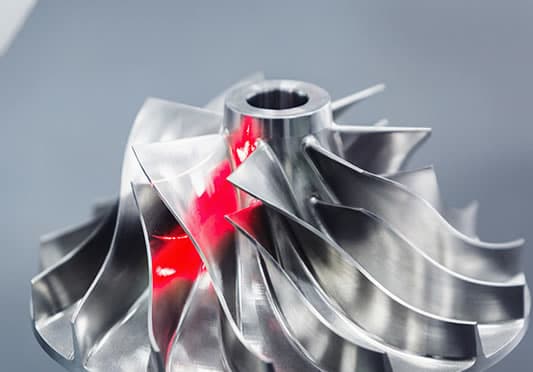
machine shops have to work with an extensive variety of materials to meet product designers’ needs. Some of these materials, like brass, are generally easy to work with. Meanwhile, parts made from other materials, like titanium, require more advanced tooling and experience to produce good results.
But what makes one material easier to machine than another? Machinability! This article will delve into what machinability is, how to measure it, and tips for making machining more efficient.
Machinability is a material property that describes the relative ease with which a material can be machined. While it’s most often used for metals, it applies to any machinable material.
A material with above-average machinability demonstrates a few important benefits during machining:
Reduced tool wear, which extends tool lifetime and lowers operating costs.
Faster machining by accommodating higher cutting speeds.
Smoother cutting with less build-up for a higher-quality surface finish.
Lower power consumption while maintaining suitable cutting forces.
On the flip side, materials with poor machinability demonstrate the opposite qualities. They are harder on equipment and tooling, require more time to machine, and require extra effort to achieve a good surface finish quality. All of this means that materials with poor machinability cost more to machine than highly machinable materials.
A number of different physical properties influence machinability, including the hardness of a specific material, its tensile strength, its thermal properties, and much more. While knowing these other values can help a machinist or materials engineer predict the approximate machinability of a material, the only way to know for sure is through machinability testing.
Understanding Machinability Ratings
CNC turned part in Swiss lathe
The most widely used method for quantifying the machinability of a material is through its machinability rating. This rating, sometimes called a machinability index, is a relative value determined from testing. Established by the American Iron and Steel Institute (AISI), a material is machined by CNC turning and the tool life, speed, and surface finish are compared against the reference material, AISI B1112 steel having a 160 HB hardness.
Machinability ratings work similarly to the Celsius and Fahrenheit temperature scales in that a somewhat arbitrarily chosen value reflects the reference point. In these temperature scales, the baseline is set around 0°C and 0°F. In the AISI testing method, the free-machining steel AISI B1112 is set as the reference point with a machinability rating of 100%. From there, materials that machine faster and easier than B1112 steel score a value above 100%. Materials that take longer to machine and are harder on tooling have a rating below 100%.
For example, the very difficult-to-machine ASTM Grade 5 titanium (Ti-6Al-4V) has a machinability of just 17%, while SAE 6061 aluminum has a machinability of 270%. However, these ratings are ultimately just a guideline for establishing the relative difficulty to machine a particular material. There’s actually quite a bit that designers and machinists can do to make machining more efficient.
Can You Improve Machinability?
CNC milled part
How “machinable” a metal is influenced by both changes to the workpiece and changes to the machining process. If machinability is an obstacle to the design, one of the first questions should be, “Can we use a different material?” Even if that just means choosing a more machinable alloy instead of switching to a whole different metal.
But if the metal alloy cannot be changed, there are still options. Work hardening and certain heat treatments applied to a metal earlier in the production process can make it much harder to work with. As much as possible, fabrication methods and treatments that cause hardening should be done after machining. And if this isn’t possible, you can consider annealing the workpiece prior to machining to relieve internal stresses and soften the metal.
Outside of workpiece material, there are many factors affecting machining efficiency, such as the machining method used, coolant application, tooling, cut path, and more. By leveraging different types of equipment in a machine shop, like wire electrical discharge machining, you may be able to reduce fabrication times. Using tooling with a different design or made from different materials may accommodate higher speeds while improving tool life.
Improving machining efficiency without changing the workpiece is best done on a case-by-case basis. For example, while thermoplastics are soft, their properties make them difficult to machine without melting and binding to the tooling. Using a material with higher machinability is one option, but controlling temperature through special coolants and adjusting machining parameters can prove equally effective.
Efficient Processing for Hard-to-Machine Parts
Inside Gensun Precision machine shop
Machinability is a key indicator of the time and cost of manufacturing a part out of any material. Workpieces with high machinability ratings are easier to produce, while less machinable materials need more time and expertise to process efficiently. In either case, a top-tier machine shop can often improve throughput while maintaining quality by adjusting its approach to reflect the specific materials and part designs.
XTJ is a leading OEM Manufacturer that is dedicated to providing one-stop manufacturing solutions of Machining 6061 Aluminum from prototype to production. We are proud to be an ISO 9001 certified system quality management company and we are determined to create value in every customer relationship. We do that through collaboration, innovation, process improvements, and exceptional workmanship.lication: Automotive industry, Bicycle and motorcycle, Door and windows and furniture, Household appliance, Gas meter, Power tool,LED lighting, Medical instrument parts, ect.

